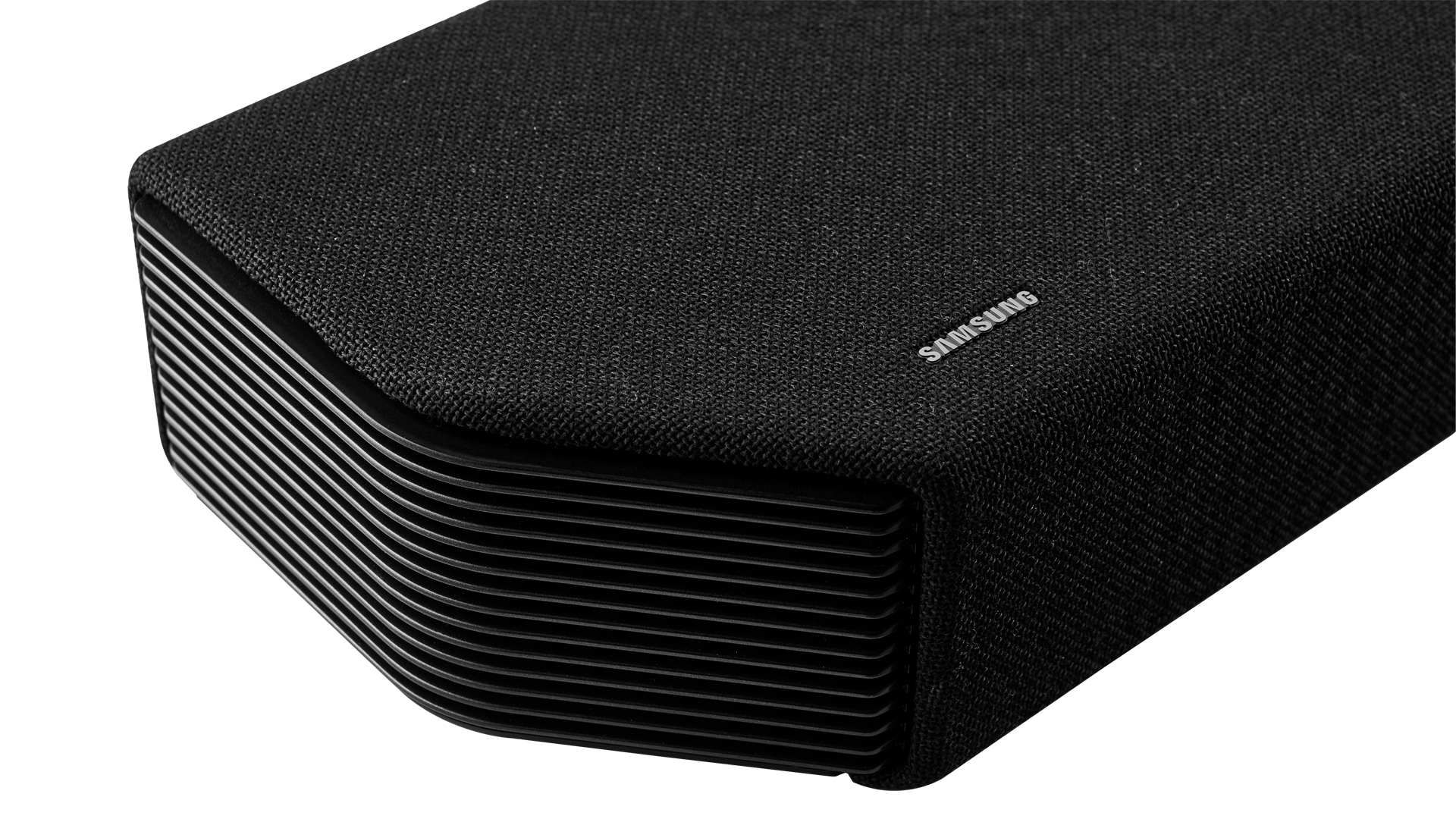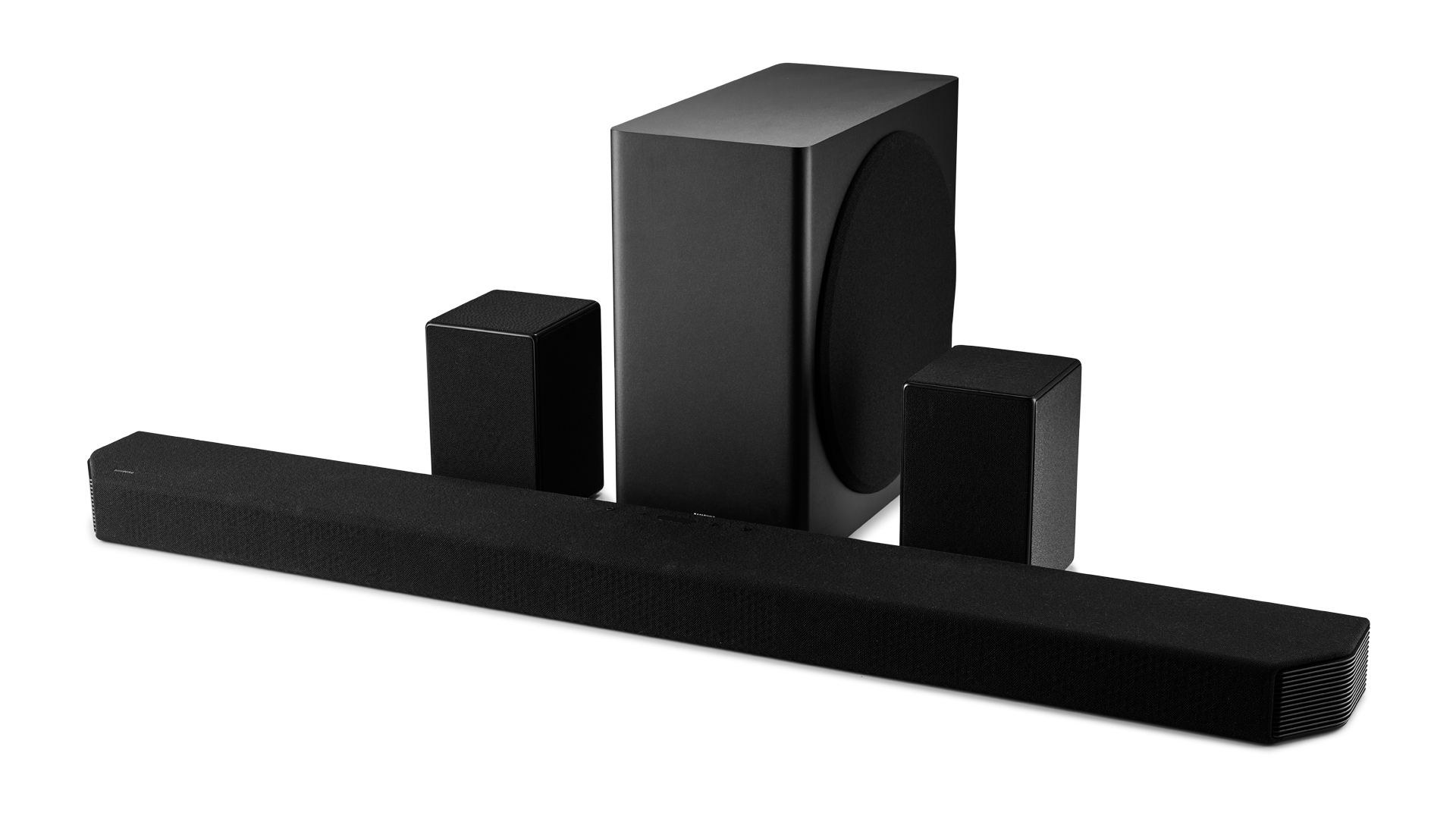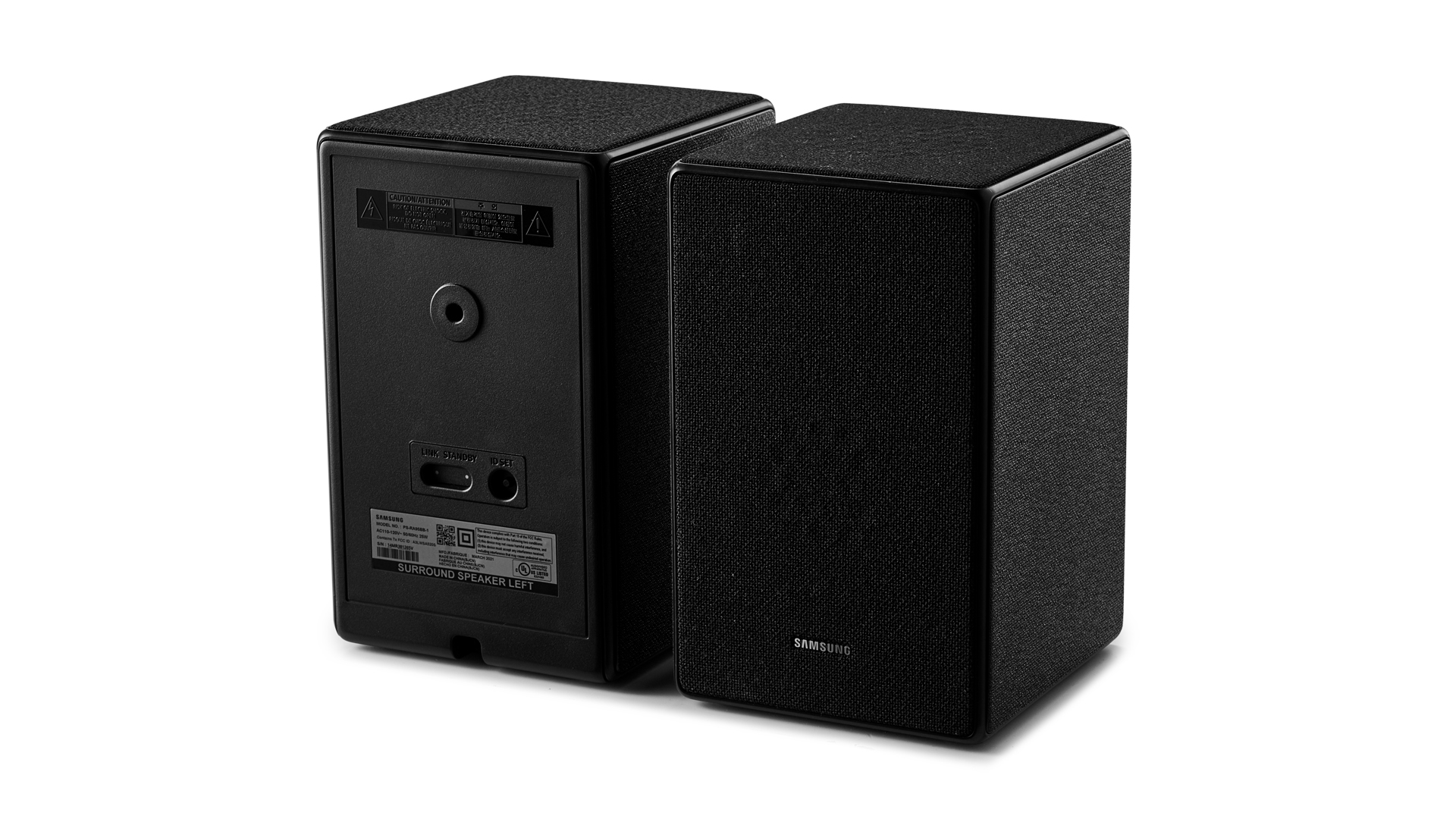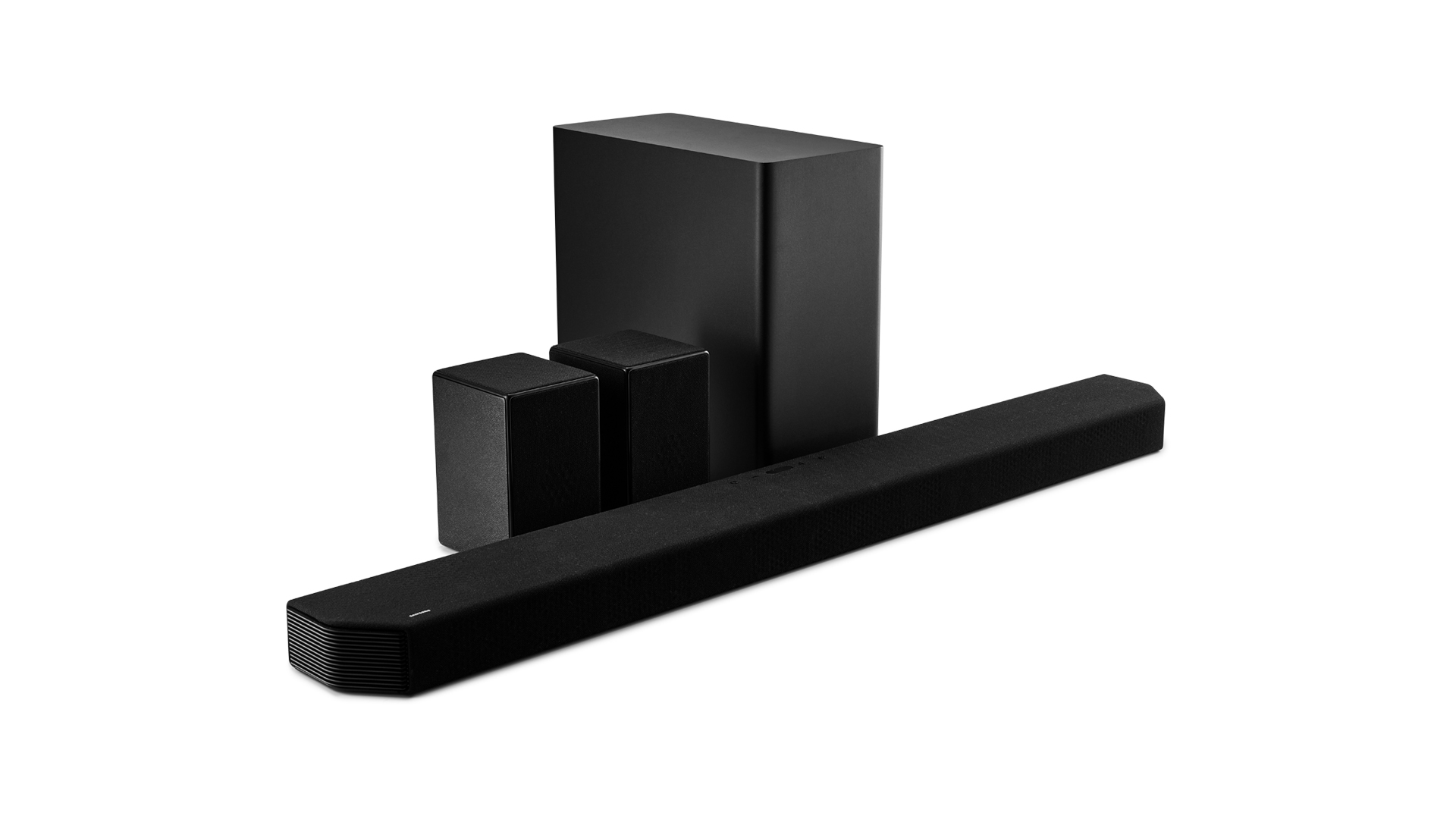What Hi-Fi? Verdict
The HW-Q950A is a forthright and punchy performer with crystal clear vocal delivery and plenty of features
Pros
- +
Extremely present centre channel
- +
Room-filling sound
- +
Excellent feature set
Cons
- -
Rears can be distracting
- -
Subwoofer not well integrated
- -
Not the most nuanced or dynamic
Why you can trust What Hi-Fi?
Mae West once said that ‘too much of a good thing can be wonderful’. It’s a mantra in praise of decadence shared by other lavish luminaries including Liberace, Nigella Lawson and, seemingly, the design team of Samsung’s HW-Q950A soundbar package.
With a generous 22 drivers delivering 11.1.4 surround sound, the HW-Q950A offers the greatest number of channels of any soundbar on the market right now, as well as 3D audio format support from both Dolby Atmos and DTS:X. But, unlike sequins and saturated fats, when it comes to immersive sound, does more always mean better?
Price

Priced at £1600 / $1800 / AU$2100, the HW-Q950A is Samsung’s top of the range soundbar for 2021 and replaces last year’s HW-950T, which launched at more or less the same price. Almost all of Samsung’s soundbars come with a separate sub and some of the company’s cheaper 2021 Dolby Atmos models, such as the HW-Q800A £799 / $700 (around AU$1470), can be upgraded to surround packages through the addition of the SWA-9500S 2.0.2 wireless rear speaker kit, which sold separately costs £249 / $248 / AU$395.
The HW-Q950A’s main rival in terms of a Dolby Atmos soundbar package with separates is a 7.1.4 offering from LG, the SP11RA (£1500 / $2000 / AU$1849). Alternatively, there’s the more affordable What Hi-Fi? Award winning Sony HT-A7000 single-unit soundbar priced at £1199 / $1300 / AU$1699 and offering 7.1.2 channels. But to add a separate sub and (front-facing only) SA-RS3S surrounds would nearly double that cost.
Likewise, the similarly Award-winning, Dolby Atmos-enabled Sonos Arc, costs £899 / $899 / AU$1499 on its own, and can be expanded through the addition of two One SL speakers (£358 / $358 / AU$538) and a Sub (£749 / $749 / AU$1499).
Build

At 130cm long, the main unit of the HW-Q950A isn’t tiny, but it’s nevertheless shorter than many other flagship Dolby Atmos soundbars available at the moment. So it’s quite remarkable that crammed inside are a whopping 15 drivers. The left, centre and right channels comprise two woofers and a wide-range tweeter. Then there are a pair each of upward-firing, surround and wide-surround drivers. The separate sub houses a single 8-inch speaker while the wireless surround units each contain 3 drivers – one facing towards the front of the room, one upwards and the last one towards the listening position.
The extra side-firing driver in the surrounds is the main physical upgrade for the HW-Q950A, which otherwise looks virtually identical to 2020’s HW-Q950T, and we’re more than a little surprised that the company has decided to stick with this design.
The latest hi-fi, home cinema and tech news, reviews, buying advice and deals, direct to your inbox.
Covered in black Kvadrat fabric with cut-off corners and heatsink-like vents at each end, the main bar has more than a touch of Brutalism about it. Some may appreciate this blocky, minimalist look despite the cover being a static magnet for hair and dust. But considering the high price point, this package doesn’t feel very premium, particularly the sub, which is indistinguishable in style to many of the cheaper models in Samsung’s range.
There’s another legacy design feature that has unfortunately made its way onto the HW-Q950T – the fuzzy LCD display positioned bizarrely on the top surface of the main soundbar. We can appreciate that with so many drivers packed inside, real estate on the soundbar’s frontage must be at a premium. But the tiny display is completely unreadable when using the included remote from a viewing position, which we can’t help but feel rather defeats the purpose of having a screen at all.

Connections eARC, 2 x HDMI, optical
Sound formats Dolby Digital Plus, Dolby True HD, Dolby Atmos, DTS:X
Video passthrough 4K@60fps HDR 10+ and Dolby Vision
Bluetooth Yes SBC
AirPlay 2 Yes
Voice control Amazon Alexa built-in
Dimensions (hwd) 7 x 123 x 14cm (bar); 40 x 21 x 40cm (sub); 20 x 13 x 14cm (surround)
Weight 7.1kg (bar); 9.8kg (sub); 1.8kg (surround)
This wouldn’t be such an issue if Samsung were intending for users to primarily control the soundbar using its quite comprehensive SmartThings app, but there are certain controls that are only accessible using the remote.
The app does however allow you to adjust the bass, treble and multiband EQ settings; subwoofer level; switch sound modes (Standard, Surround, Game and Adaptive Sound) and additional settings (Voice and Bass Enhancements, and Night Mode). It also has an ‘Auto EQ’ feature to automatically calibrate the system for your listening space.
‘Auto EQ’ is a relatively simple process that uses a mic on the subwoofer and seems to focus on refining low frequencies but if you have a new Samsung TV (2021 Q70A or higher) you can take advantage of the more advanced ‘SpaceFit+’ technology, which uses the TV’s inbuilt mic to analyse the level and direction of reflected sound waves, adjusting the audio accordingly. It’s still an understated enhancement, rather than a full room calibration, but one that’s worth trying if your TV has the capability.
Another symbiotic feature that all of Samsung’s Q soundbars offer when used in conjunction with newer TVs from within the brand’s ecosystem (2021 models and 2020 TVs from the Q80T and above) is ‘Q-Symphony’. For those who feel that a paltry 22 drivers just simply isn’t enough, ‘Q-symphony’ will combine the Q950A with your TV’s internal speakers to add height and space to the soundfield.
Recessed at the rear of the main bar are two HDMI inputs and one output (with support for eARC), an optical-in and the power socket. Four controls for volume, microphone mute and power/source sit on top, and on the underside are buttons for connecting to wi-fi and manually linking the main unit to its sub, though our review sample paired automatically. The soundbar’s microphone allows for commands to the built-in Amazon Alexa voice assistant and can also be used to monitor background levels, as the Q950A has an optional feature to boost the centre channel for clearer dialogue if ambient noise increases – though we doubt you’ll feel the need to use it.
Sound

The choice between a single soundbar and a package with surrounds and a sub depends on customer preference, space and budget. Extra boxes don’t always mean better value but when it comes to creating a cinematic film or gaming experience, enveloping surround audio and room-quaking bass are often top of the list for people looking to upgrade their home setup. And in this respect, the Q950A delivers the goods.
We have a suspicion that the Q950A will be well suited to Blade Runner 2049 and its driver-shaking score and immersive Dolby Atmos sound design, and we are immediately impressed by the sheer level of punch that this system has to offer. The main bar itself has a pretty wide tonal range, plenty of attack and exceptionally clear dialogue projection. We’re slightly disappointed by the sub’s performance, however: while it adds plenty of low end to the undulating score and intense action sequences, it doesn’t always integrate well with the main bar, at times overpowering it even after much tweaking of the level and EQ.
In terms of vertical effects, it’s only in quieter moments, such as the drone after K returns to the orphanage, that we get much of a sense of height. It’s not that the upward projection is particularly weak but the rest of the system is so forthright that these elements seem sometimes to be masked.
Swapping over to Gravity, also in Dolby Atmos, the surround sound radio communications at the start of the opening scene that should gradually fade into focus are very present from the get-go and we start to find that the extra drivers in the satellite speakers often create a lack of coherence when there are heavy surround elements, negatively impacting subtlety and spatial precision.
Things are improved slightly by putting the soundbar into Standard mode, which seems to be the only setting that doesn’t use the surround speakers’ side-firing drivers. Unfortunately, every time we change film or input the sound mode automatically switches back to Adaptive, which favours putting movies in the all-singing all-dancing Surround mode.
But in louder moments, the Q950A really shines, producing a room-filling, dramatic performance, and no matter how busy things get we’re amazed at the way the centre vocal channel can cut through the noise.

For a package that seems built for action, we find that the Q950A is more enjoyable to listen to for long periods when there are less intricate soundscapes involved. Streaming Squid Games in Dolby Atmos on Netflix, the dramatic tension gradually building up to the first game is heightened by the Q950A’s thunderous delivery of Handel’s Trumpet Concerto in E as well as the clearly defined trills and whirs of the giant animatronic doll. It may not be quite as effective at conveying variations in space as other soundbars, but its sharp, detailed presentation and ability to convey 360 degrees of sniper gunshots before erupting into a rousing rendition of Fly Me To The Moon very much enhances the suspense and impact of the viewing experience.
When listening to the cooly melancholic Summer Has Flown by Katherine Priddy, the attack of the acoustic guitar and warmth of the vocal are nicely presented, with plenty of richness despite the sparse arrangement. With a busier track such as No Way by Boogaloo Joe Jones, the timbre of the saxophone and guitars feels a bit constrained, and when instruments double each other there often isn’t much tonal distinction or separation compared with competitors such as the Sonos Arc or Sony HT-A7000.
However, the external sub of the Q950A reaches down to frequencies that single soundbars couldn’t hope to match, adding real depth and weight. In My Queen Is Nanny Of The Maroons by Sons Of Kemet, the low percussive elements have a melodious, if slightly outsized, quality, while the rhythmic backbone retains its strong, responsive leading edge.
Verdict

With plenty of sonic vigour, features and, of course, speakers, the Q950A offers a potent listening experience.
We’d prefer if all that driver power could be more coherently harnessed and it’s certainly not the most nuanced or spacious performer, but those with deep pockets looking for a soundbar that can deliver big, punchy audio and supremely clear vocals will likely not be disappointed by the Q950A.
SCORES
- Sound 4
- Features 5
- Build 4
MORE:
Also consider the Sony HTA7000
Read our review of the Sonos Arc
See our LG SP11RA review
The best soundbars you can buy
What Hi-Fi?, founded in 1976, is the world's leading independent guide to buying and owning hi-fi and home entertainment products. Our comprehensive tests help you buy the very best for your money, with our advice sections giving you step-by-step information on how to get even more from your music and movies. Everything is tested by our dedicated team of in-house reviewers in our custom-built test rooms in London, Reading and Bath. Our coveted five-star rating and Awards are recognised all over the world as the ultimate seal of approval, so you can buy with absolute confidence.


